Now, hear me out for a second and tell me if this sounds anything like you?
Life seems to be going well lately. You managed to fit some exercise time in the gym, you’re taking care of your diet, you’ve been deep conditioning your hair every week without fail, in sum, all boxes are checked. Oh yeah, you’re nailing it!! At least, that’s how you feel. Taking care of your hair doesn’t seem that hard to do, does it? And there you were listening to all those pessimistic prognostics of what could go wrong with your curly hair when in reality you got it all covered.
Except, one day you notice all these little pieces of hair around the house and think – “Hmmm, how did this happen?… Oh well, it’s just a few hair pieces nothing wrong with that. Curly hair is naturally dry so there’s bound to be some breakage. We can’t control it 100%!”.
This is what you say to convince yourself that there is no problem, but soon a few pieces of hair turn into a trail of broken hairs and then suddenly, one day, the other inhabitants of the house start to complain about all the hairs roaming around. This is when all of a sudden all flares light up in your brain and you think – “OMG, I have a problem. I have hair breakage!”.
Yes, dear, you have natural hair breakage. Now raise your hand if this sounds anything, remotely like you? It does!? Then welcome to the group cause it’s never lonely in here. Yeah, this was my story.
If you’re shocked and surprised to hear this, don’t be!
Should I be ashamed to reveal this about me? Am I not supposed to help you navigate through this deceptive hair journey?… Well, let me be honest with you and say – “No! I’m not ashamed to say that this was my story a while ago.“
Why?
Because, as I said many times before on this blog, it is by doing (and many times by making mistakes) that we learn how to do things and what to avoid and my story, my curly friends, might be able to help you (or anyone else) avoid my mistakes. And what better way for me to help you than to share my experiences and what I’ve learned from them?
Can you truly relate and learn from someone who says they never had a bad experience throughout their hair journey?! We all had them or we’re bound to have them soon. So please, stick around I’d very much love to have you here. Maybe you can share your story too (in the comments sections please) and in the process, you can download your own FREE Guide to help you overcome your breakage.
1st Step | Recognise You Have A Problem
Recognising you may have a problem is the first step taken towards reverting a possible negative situation. Don’t brush the problem aside like I did thinking it’s probably nothing. If you find the ship has already sailed and breakage is installed this initial step will help delay the progress of a bad hair condition. Still, this can only happen if you take action afterwards.
But first things first… Do You Know What Natural Hair Breakage is?
You might think this is an obvious question, but many people get hair breakage confused with hair shedding. Hair shedding is when you get a hair strand that has its “head” still attached to it. This simply means the hair fell with its root still on, a white bulb. This is quite normal, it happens during the telogen phase of the hair cycle, it’s when your old hair is replaced with new one. During this phase, your hair will shed whenever you shampoo or comb it.
Hair breakage, on the other hand, is when the hair snaps/breaks in a section of your hair length and you’re left with a short piece of hair that can have different lengths, but always smaller than your normal hair length. Contrary to hair shedding, hair breakage as some sort of underlying issue, a reason for it to be happening.
So, why is it important to know the difference between the two?
Because my curly friend, we don’t want to fix something that doesn’t need fixing – “If it ain’t broke, don’t fix it!”. In this case, if you have hair shedding there’s nothing you can or should be doing about it (keep your hands off!). The only exception happens when it’s related to medication, an illness, postpartum hair shedding, stress levels or hormones. In this case, you need to speak to a doctor. Let’s continue to step 2 because hair breakage is a whole other issue.
2nd STEP | Assessment – Is There A Cause For Concern?

This is a tough one to answer because as I hinted out before, natural hair is prone to dryness and consequently, breakage will be inevitable at some level. The question is, do you correct the issue promptly or do you dismiss it as a natural occurrence when it’s minimal? You can moisturise your hair the best you can, have the greatest products or have a hair regimen that works, but if you slip on one or all these practices you can see it emerge.
Moreover, although hair breakage should be an unseen event in our lives it is unrealistic to think that it’s a possible event. Only in Disneyland, where dreams come true, can this be possible (I so wish I could live there, don’t you?). Think with me, even if you do everything right with your hair there are variables you can’t control that influence the health of your hair such as the sun, the wind, high and low temperatures, air conditioning or even sea breeze. Sure you can minimise unwanted effects, but you’re not able to neutralise them.
So the question remains, how much hair breakage is alarming? It depends on a number of things as it’s different to each person. What constitutes a danger zone for a person may not be for another. But the real sign of problem would be if your hair growth is undermined. To say it bluntly, if your hair breaks as much as it grows then you have a real problem. However, you shouldn’t let things get things far.
Things to consider:
Hair Shape – For kinkier hair types, which can sometimes have a “z” shape, hair breakage can be greater when compared to a looser curl shape. This is because when you are stretching or manipulating your hair the hair is forced out of its normal shape and can break easily. The places where it bends are high breakage points. It’s a normal feature for this hair shape.
Hair Density – Those with high-density hair have a higher hair breakage threshold than those with low-density hair, just because they have so much hair.
Transition To Natural Hair – If you’re transitioning, as was the case at the time of my ‘hair episode’, breakage above the average is to be expected, because your transitioning hair is more fragile, especially at the line of demarcation.
The key point to take from all this is that no one knows your hair better than you, even if you don’t think so. Paying attention to your hair is paramount on this hair journey, so play an active role in it! However, if you only notice breakage signs too late and you started out in a “normal hair condition”, counting more than 10 hair pieces probably constitutes a problem you might want to tackle (is this too much or too little for you? For me it’s a brow raiser). Once you determine you do have cause for concern you need to pinpoint the root of your headache.
3rd STEP | Identifying The Problem(s)
Going back to my opening story, as soon as I got over the shock of my debacle I started an intense audit throughout my hair care routine, my products, my hair accessories/aids, you name I did it. So to get you too on audit mode I want you to 1) keep your hair routine on pilot mode (this means focusing on keeping the hair moisturised, avoiding heat and the use of protein treatments) and 2) consider a few of the following questions.
Hair Care Routine
- How do you maintain your hair between hair washes?
- Do you wear your hair in protective styles?
- How tight do you wear your hair?
- If you wear your hair in braids, locs, twists, etc do you keep them moisturised? How often? How long are they in? Are they heavy?
- Do you use glue for your hair extensions? (use glue)
- How often do you trim your hair?
- Do you finger detangle or use a comb? Do you section your hair?
- Do you dye your hair regularly?
- How often do you use heat? (Do you use a heat protectant/ control temperature…)
- Do you have the omg-my-hair-is-so-beautiful-I-can’t-stop-touching-it syndrome?
Products
- Do you use products with silicones?
- How often do you clarify your hair to remove build up or hard water minerals?
- How often do you deep condition for moisture?
- How often do you deep condition for protein?
- Do you deep condition overnight?
- Do you use a sulphate free shampoo?
- Do you pre-poo your hair?
- How do you pre-poo your hair?
- Do all, some or most of your hair products have proteins in it?
Accessories
- Do you wear a satin bonnet and/or pillowcase to sleep on?
- Do you use satin lined hats or beanies?
- Do your hair accessories have sharp or pointy metal parts it?
- Do you use cotton scrunchies?
- Do you tie your hair in rubber bands?
These are just a few questions to get you started, there is no scratching the surface here. Hair breakage is a real problem for naturals (if not the biggest problem, coupled with dryness) so let’s take actionable steps to really identify the problem so you can avoid making them in the future or, if you do make them, you’ll be able to tackle them.
Therefore, if you really, really, really, want to succeed in this journey click on the link at the end of this post and you’ll be able to download a Free worksheet to help you come up with a strategy. Answer the questions truthfully, click on the links if you need further help and I’m confident you’ll be able to identify your problem. Print your free worksheet to start controlling your hair breakage today! Wait, wait, wait… first, you have to finish reading the post so you know what to do.
4th STEP | Create An Action Plan
After my audit I gathered my findings, analysed them to see what went wrong and stopped, modified or adopted behaviours. I discovered I strengthened my hair too much by dyeing my hair with henna first (which is not a protein treatment but works as such in the hair’s cortex) and then by deep conditioning with protein. This moment was where it all began for me.
The real mistake happened when I noticed my breakage and I thought I had moisture overload, so I tried to correct it with more protein every other week for a month until I saw no improvements and said, “Wait this is not working, let’s rewind”. My initial problem was not connecting the henna dye with my regular protein treatment. I should have left a bigger space between them and not top it up with more protein. So what did I do to put an end to this?
I completely put a stop to protein in my hair regimen (no deep conditioning or products with it in it). I modified my deep conditioning treatments and only did them for moisture and nutrition with heat application. I also changed the oil in my LOC method and if needed, I hydrated my hair more often during the week (spray bottle or co-wash). I kept my hair in a protective style and adopted a tea rinse in my washing routine.
If you answered all of the previous questions (and came up with a few of your own) hopefully, you’ll be able to see things clearer. I don’t know about you, but putting things on paper helps me think clearer rather than having random thoughts in my brain bump into each other. So I hope you enjoy my little 4-page worksheet guide. Let me know what you discovered.
5 STEP | Implement A New Hair Routine
Wanna know about my results? Well, I noticed immediate changes in the amount of hair breakage and a complete crisis was averted within 3 weeks. Amazing, right? But all could have been prevented if I had paid more attention initially, don’t you think?
Maybe you think it was a rookies’ mistake and it could have been totally avoided. But hey, not all of us have it all together with being a mum, wife, blogger and all in-between. It’s hard work ladies, what can I say!? Sometimes things get out of balance, but the important thing is to get back on the saddle!(but you probably already know this, don’t you? 😉 )
But enough about me… So, what can you do to control hair breakage, you ask? If you were paying attention, I already gave you a hint earlier before. You can download the Free Worksheet!!! Remember?! You can go through the same steps I did, gather your intel, analyse it, draw your own conclusions and devise an action plan to avert hair doom. Oh, and once you download it, if you need extra help with the questions there are links provided with extra information. Or you can join our facebook group The Curly Queen Adventure, where awesome curlies get together to talk all thing’s related to #curlyhair.
Click the link below for your free download and also check out the fancy infographic I made with everything summed up for you so you can save it on your Pinterest. Cool, right! Now get to workin’!
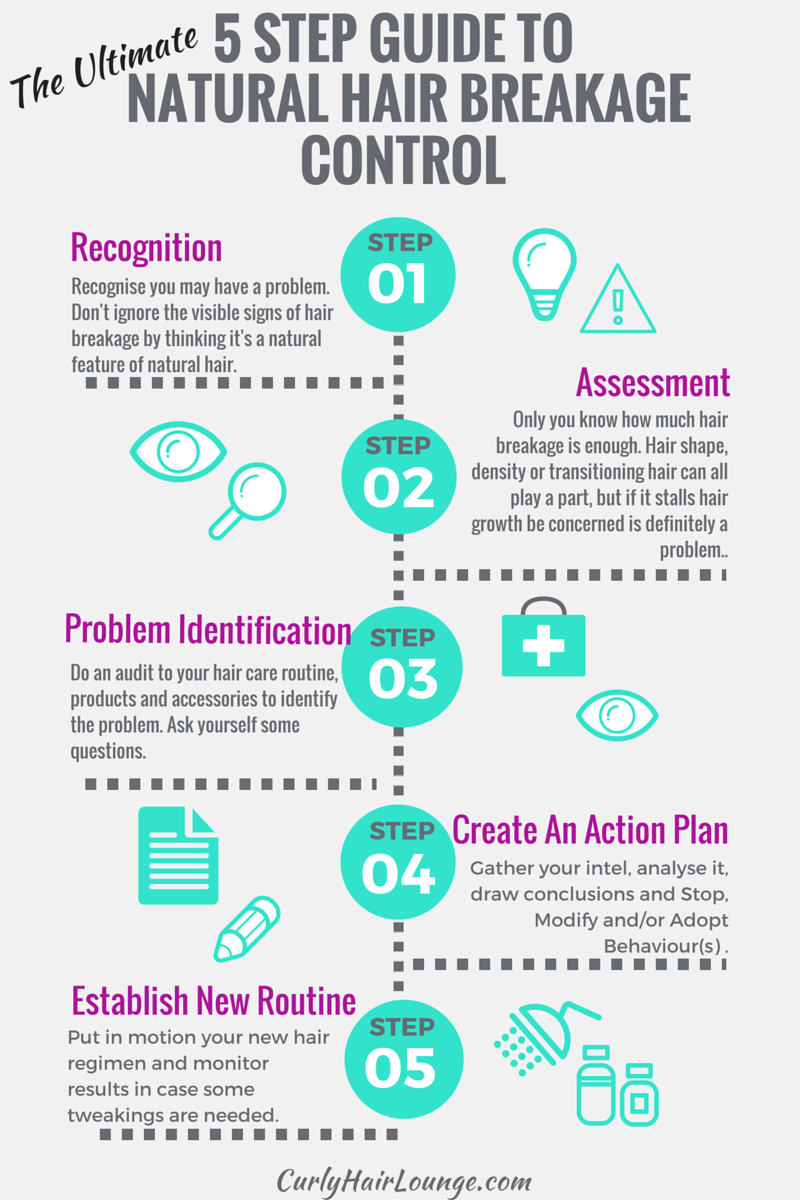
Have you suffered from hair breakage? What did you do to control it? Can you share your actionable steps?
Featured Image: YouTube NaturalMe4c

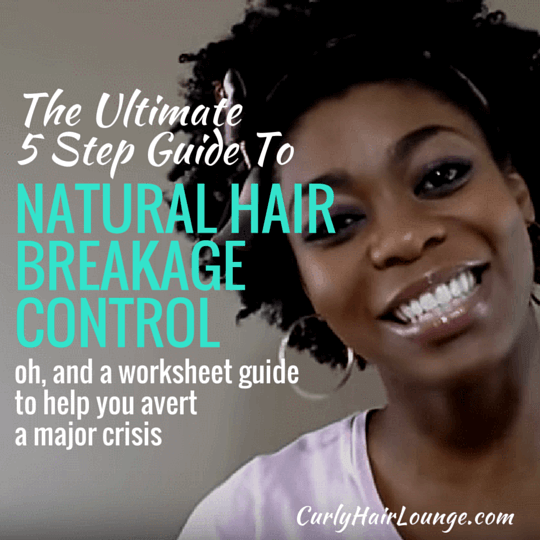

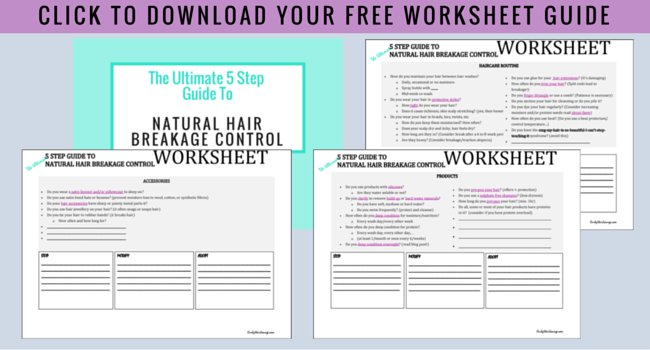
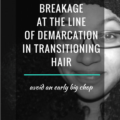
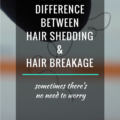
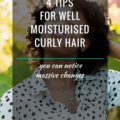
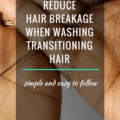
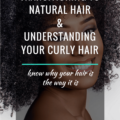
4 thoughts on “The Ultimate 5 Step Guide To Natural Hair Breakage Control”
hi, thanks for all your researched info. I have reviewed this breakage worksheet and cannot identify my issue. My only negative points are- maybe too much oil- I do it twice per week; too much products – I am quite generous with LOCS products. not even sure of the correct amount.
I dont have split ends, my hair feels “moisturised” but I dont spray with water. I usually oil 2X per week and cream 2X per week. I deep protein condition 1X 5 weeks. Cowash every 5 days. Pre-poo and ALOCS always, Poo 1X5 weeks.
All that and my hair does not grow much, I have single strand knots and breakage which I describe as lots of short hairs near to the scalp(uneven length)
What am I missing?
Hi Jennifer,
Sorry to hear you have breakage and can’t identify the problem. If you’re doing the LOC method I would not recommend that you oil your hair 2x week. If you’re generous as you say you are with the LOC method (as I am) your hair should be and stay moisturised for a few days (maybe even for a week) without the need to oil it, especially if you keep your hair in protective styles. However, if you feel you need to moisturise your hair you should apply a water based moisturiser or even just water and then an oil. You can’t apply oil on dry hair, it will dry your hair even more and cause breakage.
I didn’t get if you apply a cream and oil 2x per week (in this order) or if you do it on separate occasions. Is the cream’s 1st ingredient water? There are also a number of different factors that can contribute to your condition, try and read this post you could find there the reason why you’re dealing with breakage.
Monica
I can’t find the breakage worksheet even after looking in the library. Can somebody help me??
Hi Ife, the resource is there it just has a different cover (teal). 🙂